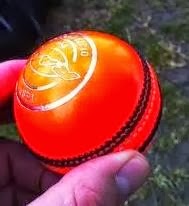Orange ball blooms then fades
 |
| An orange ball similar to the ones used by us in Pembs not the exact one I hasten to add. |
Apologies for the delay in posting blog number two, I just
haven’t summoned the energy to get up and write it which is probably a
combination of being shattered from looking after a poorly two year old,
rendering the nights long and restless; and the blues setting in knowing that I
won’t be donning the whites again in 2013.
The end of a cricket season can bring relief if you’ve had a
tortuous few months but anguish and despair if it’s been relatively decent. I’m
somewhat torn between the two with decent performances interspersed with those
ranging from indifferent to embarrassing. Anyway, enough of my travails at
Lamphey let’s talk about something topical, like orange cricket balls.
The announcement that a decision had been made to trial
orange cricket balls in the much tinkered with Duggie Morris cup brought a degree
of excitement to the County AGM two years ago. ‘At last,’ one thought, ‘we’re
going for something a bit radical, something that could jazz the game up.’
For those eligible to play in the competition the trial
allowed us to play with a ball that was easy to pick up in the evening light
especially in gloomy conditions.
It was great. Fielders weren’t diving for cover wondering if
a booming cover drive was firing its way at them as they failed to pick it up
against a backdrop of shrubs and trees while batsmen could pick it up at
grounds without side screens.
Sure, the ball swung more and made a funny plastic sound when
it did meet with the middle of the bat but at least you could see it sail over
the boundary for six as we did quite often the first time we used it at Lamphey
as St Ishmaels scored something like 200 for 2.
We were eventually bowled out for 20 odd in reply, (it could
have been more it could have been less) but the result was an irrelevance to us
that night as the visiting fielders obviously found the ball to their liking
making catching look simple in the fading light of a mid-May’s night and we got
a chance to play with something out of the norm.
Playing with the orange ball was good, definitely something
to consider for Saturday cricket too for the benefit of all teams and not just
those that had qualified for a competition for Harrison-Allen and division one winners
only.
Yet not all feedback was good, the ball was too hard for
some with a few batsmen breaking their bats as a result so after two years of
trying, the county’s executive has decided to revert back to the red balls as
opposed to trialling a different manufacturer.
“It’s all to do with costs,” said league secretary Steve
Blowes. “It’s the second orange ball that we’ve trialled so we decided against
trialling another orange ball as the costs would be that much higher and we
didn’t think the clubs would pay for it.”
It’s a presumption to say they thought clubs wouldn’t play
for it but he’s probably right. With balls costing upwards of £10 a time (and
that’s a basic figure) if you are knocked out of the first round most years
like we in Lamphey now are, it’s not too much of a problem but if you reached
the final, you can expect to have a new ball each time and in the Duggie, that
means four games and possibly five innings so you’re looking at £50 before you start
(and that’s a conservative figure)
The reality though is that we’ve been served by substandard
balls in the county for too long. Years
ago, it was up to the club to buy their own, they could have whatever they
wanted. Some clubs had the best, some didn’t. Not every side used a new ball,
in damp and gloomy conditions you don’t need to.
In the 1980’s clubs dabbled with the compound ball, a
seamless object using man made materials which was basically rubber and
plastic. It swung like a banana, was virtually waterproof and flew off the
middle of bats but somehow it didn’t feel real and it didn’t last long. It may
have looked like a cricket ball but it didn’t behave like one.
The traditional ball came back in vogue.
Then it was decided that all clubs should use the same ball.
This would provide a level playing field of sorts and bulk buying could allow
clubs to spend less on the most vital component of the game.
But like anything in life, you pay for what you get and
paying less doesn’t necessarily equate to it being good.
Many players and not just me have said the ones we use lose
their shape, the consistency of the lacquer is indifferent and like the orange balls
they are too hard; bats have been broken and more bats could break so it’s not just
the orange balls that need to be looked at, the red ones need looking at too.

Comments
Post a Comment